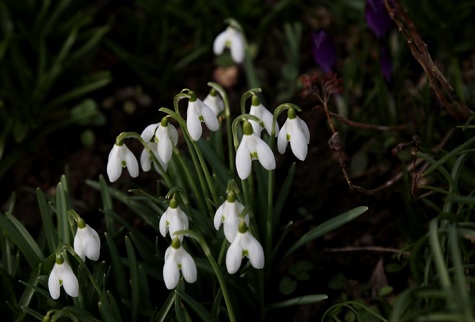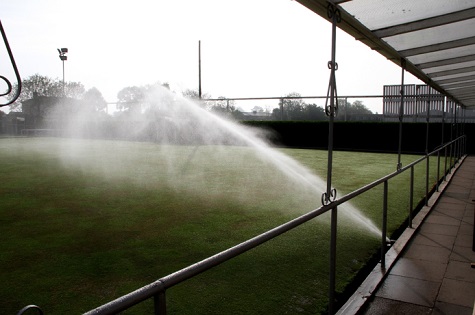With air temperature well into double figures for most of January and the start of February, we are certainly in for an early spring floral display - ratified by recent research seen in a BBC news item.
The story states that it has been documented that climate change is causing UK plants to flower almost a month earlier on average. Just as autumn leaf fall is being delayed by warmer weather, flowers are appearing earlier on trees and shrubs.
The BBC says, “But while some might welcome these untimely blooms, scientists are warning of the risks. They say if the trend continues, there are likely to be some knock-on effects for birds, insects and whole ecosystems.

“Ecological mismatch may kick in, which would have a dramatic effect "on the functioning and productivity" of nature and farming, said lead researcher, Prof Ulf Buntgen of the University of Cambridge.”
The piece goes on to explain that global warming is causing spring to arrive early and autumn to come late in many places, and not all plants and animals are adapting at the same rate.
Scientists warn that if species get out of sync with each other, this could have disastrous consequences - a concept known as ecological mismatch.
I myself have seen the emergence of a number of butterflies in the last couple of weeks along with a number of ladybirds.

This unusual warm, dry weather has certainly been welcomed by many of our grounds professionals. Most parts of the country have not had to deal with snowfalls and heavy frosts, thus reducing the workload of having to manage the use of frost sheets and covers.
Also, many grassroots level, soil-based pitches seem to withstand the toil of winter games fixtures due to this spate of dry weather. However, we may still get caught out. It seems we may be facing some wet weather fronts, as predicted by Mark Hunt from Headland, who provides a fascinating insight to our weather on his weekly weatherblog that’s well worth a read.
Watering regimes
Having spoken to a number of groundsmen, they have all commented on the recent weather and have had to implement some watering of their playing surfaces.
It usually at this time of the year you should be auditing and servicing your irrigation systems ready for the start of the growing season.

Nowadays, irrigation is an integral part of the turf grass management industry, especially as the demand for better quality playing surfaces has increased. This demand has been largely due to extensive televised coverage of major sporting events. Seeing immaculate, aesthetically presented golf courses, football & rugby pitches and horse racing courses has increased the expectations of players and viewers.
Most professional sporting facilities have irrigation systems of one sort or another. Without them they would not be able to prepare and maintain their playing surfaces.
Water is influential in all chemical, physiological and biological processes of plant growth. The soil/plant water relationships is critical to the sustainability of any grass plant. Understanding these relationships is critical. All grass plants are a continuum of water movement. Over 90% of the plant's water requirements are transported through the plant from the soil profile, via the roots and stem tissues into the leaves and out into the atmosphere. Knowledge of these relationships is important when designing and operating irrigation systems. The main aim is to achieve a water balance within the soil profile ensuring that the grass plant can access available water from the soil.

Uniformity is the critical design factor of any irrigation system. The position, distance between and working range of the heads is crucial to uniformity. It is important to measure the uniformity of the heads on a regular basis to ensure that the system is operating correctly. This is done by placing receptacles (buckets) in a grid formation at set distances to collect the water. The water in the buckets is measured to see if there has been a uniform distribution to the surface target area.
Irrigation design engineers and manufacturers have now developed and offer a wide range of sprinkler products that can accommodate most facility requirement and applications, (greens, tees, fairways, football/rugby pitches, bowling greens, artificial pitches and horse racing tracks). All facilities require the appropriate system design to maximise the resources available. A poorly designed system cannot be made to work properly with remedial measures later, without causing a lot of disruption and cost implications.
The employment of experienced irrigation specialists/consultants will ensure that the right system is employed and, in the long term, will save time and money.
It is essential you have these systems serviced and calibrated before the start of any new growing season. There is nothing worse than these systems breaking down or not being efficient when you need them.

Running times and system output capacities are very important. Many golf coursees often have to run for 6-8 hrs to complete a watering cycle. Does the system have the capacity or flow to change the quantities required? Is there enough running time available to achieve the aims and objectives?
The optimum time for watering is from 8pm through to 8am. Watering at other times may cause inconvenience to players and affect surface playability. Watering during the day, especially in hot weather, may lead to scorching of the turf and loss of water by evaporation.
All irrigations systems are driven by water pressure. It is important that the correct specification of piping is used to conform to the pressure requirements of the system being employed. Using the wrong size piping materials and UPVC joints could result in leakage problems once the system is up and running. Leaks and loss of pressure will have a dramatic effect on the performance of the system, with the added problem that the water will be going somewhere else!
Also, the quality of your water may affect the performance of your system. Sites in areas with heavy lime deposits may require filtration systems. Similarly, recycled water (grey water systems) will require an effective filtration system employed to clean the water prior to use on natural turf surfaces.
If we continue to see an increase in soil and air temperatures as a result of global warming, then many sports clubs will no doubt have to increase their investment in their irrigation systems and look at more efficient ways of watering their sports facilities.